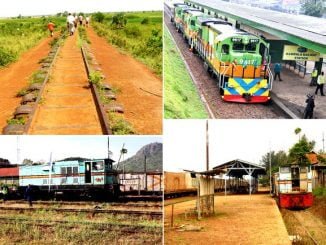
Kampala, Uganda | By Michael Wandati | Uganda Railways Corporation (URC) has announced that electric trains are not yet part of its immediate plans, despite calls for a more modern railway infrastructure.
Instead, efforts are focused on reviving the country’s rail network, with recent progress on the Kampala-Mukono line, a Meter Gauge Railway (MGR) currently dedicated to passenger services.
URC has also indicated that cargo services will be introduced in the near term, with ongoing projects to restore the Tororo-Gulu line, which passes through Mbale, Kumi, Soroti, and Lira, ending at the Gulu Logistics Hub.
In addition to the MGR restoration, preparations are underway for physical work on the Standard Gauge Railway (SGR) between Kampala and Malaba. Plans also envision extensions of the SGR to connect with the borders of the Democratic Republic of Congo (DRC), Rwanda, and South Sudan.
For the MGR lines, URC is opting for diesel-powered trains and is already in the process of procuring Diesel Multiple Units (DMUs). These DMUs feature integrated diesel engines, allowing for efficient movement without a separate locomotive.
Amid these developments, some have questioned the reliance on diesel engines when Uganda currently generates twice the electricity it consumes, prompting a discussion on the potential for transitioning to electric trains in future expansions.
“For the improvements we are doing on the MGR network, specifically for the passenger service component, there will not be electrification, at least for now. Electrification will be purely on the SGR,” says John Lennon Sengendo, Senior Public Relations and Communications Officer at URC. In justifying this, Sengendo says DMUs offer a good experience in terms of comfort and speed.
“They are modern rolling stock and are used in many countries, including the developed where electrification hasn’t been done.”
According to him, in passenger experience, the two systems are the same.
“There is no comparison with electric trains. DMUs and Electric Multiple Units (EMUs) are the same. The only difference is that one is electric and the other is Diesel,” he says, adding that the DMUs to be deployed will be able to move at speeds of 120 kilometres per hour, “which is relatively good.”
On why then, URC has chosen DMUs, at least for now, it says electricity availability is not the only factor, but the cost of building the system, too.
“A lot of work and money goes into the installation of the infrastructure, which may not make sense to do on the MGR, yet the government is constructing an SGR, which will be electric,” he explains.
Drawing insights from Kenya’s experience with Diesel Multiple Units (DMUs), which reach speeds of up to 120 km/h, Uganda Railways Corporation (URC) plans to customize its DMUs based on public feedback for enhanced comfort and functionality.
According to URC, they have incorporated Ugandans’ suggestions into the specifications for their DMU orders, ensuring a user-focused design.
While Kenya’s Standard Gauge Railway (SGR) also operates on diesel, URC acknowledges the challenge this poses for seamless operations between Mombasa and Kampala. Officials hope that by the time Uganda’s SGR is complete, both countries will have settled on an optimal approach—potentially integrating “hybrid rolling stock” if Kenya has yet to electrify its SGR. This hybrid option would allow diesel engines to operate efficiently on both electrified and non-electrified tracks.
Also Read: Inside Kenya’s luxurious SGR Premium Class Coach ahead of official launch
DMUs are popular worldwide, with countries like the USA, Canada, the UK, Australia, Japan, and Germany relying on their flexible design. Advances in diesel-hydraulic engines have also improved efficiency by allowing a switch between diesel and hydraulic power, reducing emissions, noise, and fuel consumption.
DMUs are generally more affordable to build and can run on both electrified and non-electrified tracks, offering operational flexibility.
Although DMUs are cost-effective initially, long-term electrified railway systems can prove cheaper—often after about 30 years—as overhead costs are lower, provided electricity prices are stable.



